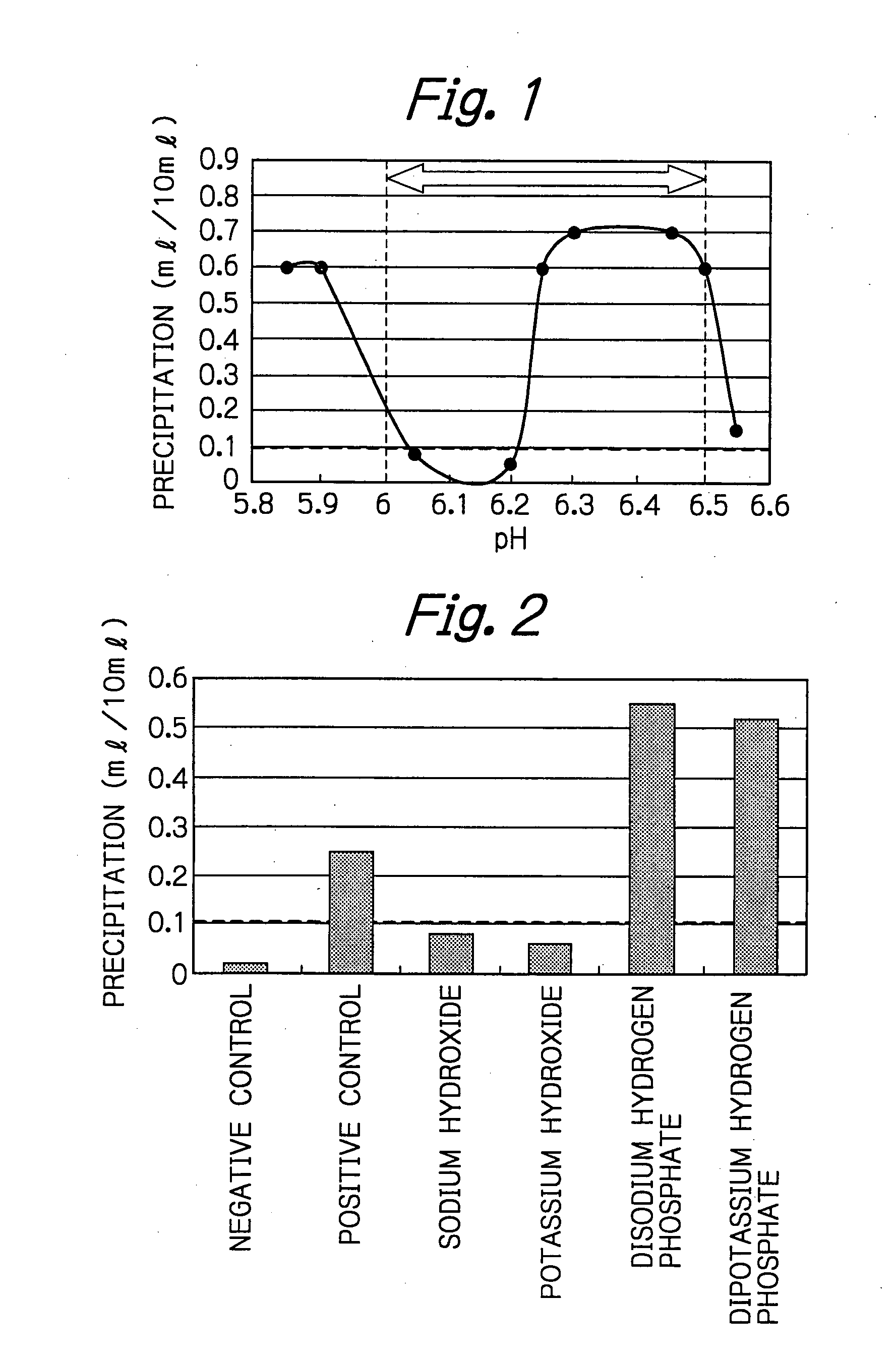Milk-added coffee beverage
a coffee beverage and milk technology, applied in the field of milk-added coffee beverages, can solve the problems of increasing product cost, affecting product value, and not providing sufficient anti-precipitation effect, so as to increase the amount of added emulsifier or thickener, and reduce the amount of emulsifier or thickener.
- Summary
- Abstract
- Description
- Claims
- Application Information
AI Technical Summary
Benefits of technology
Problems solved by technology
Method used
Image
Examples
example 1
[0057] The use of sodium bicarbonate with different pH adjustors was examined. Sodium bicarbonate was added to coffee extract in a fixed amount, using the amount which produced the least precipitation in the experiment of the Reference Example (final concentration: 0.83 g / L, product pH: 6.2) (for a pH of 6.5 at this stage), and then different pH adjustors were added in amounts giving the same pH (pH 6.8). The procedure thereafter was carried out according to the Reference Example to obtain canned milk-added coffee beverages.
[0058] Strongly basic substances (sodium hydroxide, potassium hydroxide) and weakly basic substances (disodium hydrogen phosphate, dipotassium hydrogen phosphate, sodium bicarbonate (positive control)) were used as the pH adjustors. Separately, a solution was prepared with purified water added instead of a pH adjustor, as a negative control. The degree of precipitation in each of the canned milk-added coffee beverages was measured using the same method as in the...
example 2
[0062] Based on the knowledge obtained from Example 1, all of the sodium bicarbonate was replaced with a strongly basic substance (sodium hydroxide in this case). In the same manner as the Reference Example, the sodium hydroxide concentration was added in different amounts to obtain canned milk-added coffee beverages with no emulsifier added. The results of the experiment are shown in FIG. 3.
[0063] As can be clearly seen from FIG. 3, when all of the sodium bicarbonate was replaced with a strongly basic substance, a notable effect of preventing precipitation was found in the pH range in which common milk-added coffee beverage products are distributed (a pH range of approximately 6.0-6.5, see arrow in FIG. 3).
[0064] It was thus demonstrated that to control precipitation of milk-added coffee beverages during heat sterilization, it is effective to use a strongly basic substance alone as the pH adjustor. It was also demonstrated that using a strongly basic substance as the pH adjustor ...
example 3
[0065] A test sample of a milk-added coffee beverage (emulsifier-free) was prepared by mixing the raw materials in the prescribed amounts shown in Table 1, heat sterilizing and adding a strongly basic substance, and the degree of precipitation and flavor were evaluated (Test Product 1). Two control test samples of sodium bicarbonate-containing milk-added coffee beverages (Control Product 1-1: emulsifier-free product and Control Product 1-2: emulsifier-added product) were also prepared. An emulsifier (sucrose fatty acid ester) was added to Control Product 1-2 in the necessary amount as an anti-precipitation agent.
[0066] Table 2 shows the evaluation results for the degree of precipitation and the flavor. The degree of precipitation was measured according to the Reference Example. The flavor was evaluated as the average of score by five professional panelists. Scoring was on the following 5 levels: “Good”=5 points, “Fair”=4 points, “Ordinary”=3 points, “Somewhat poor”=2 points, “Poor”...
PUM
 Login to View More
Login to View More Abstract
Description
Claims
Application Information
 Login to View More
Login to View More - R&D
- Intellectual Property
- Life Sciences
- Materials
- Tech Scout
- Unparalleled Data Quality
- Higher Quality Content
- 60% Fewer Hallucinations
Browse by: Latest US Patents, China's latest patents, Technical Efficacy Thesaurus, Application Domain, Technology Topic, Popular Technical Reports.
© 2025 PatSnap. All rights reserved.Legal|Privacy policy|Modern Slavery Act Transparency Statement|Sitemap|About US| Contact US: help@patsnap.com


